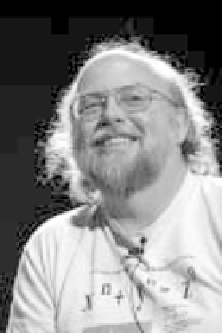Cryptography Reference
In-Depth Information
SAIL
, under the direction of John McCarthy (see page 167). SAIL closed in
1991, but business research centers such as AT&T and Xerox also had what came
to be known as hackers of the second wave due to their expertise. Among this
second wave, in addition to Stallman, were Ed Fredkin, Jim Gosling (see Figure
10.3, courtesy of Jim Gosling), Brian Kernighan (see Figure 10.4, courtesy of
Brian Kernighan), Brian Reid, and Dennis Ritchie.
Fredkin
: Ed Fredkin had no university degrees, yet he learned about com-
puters in the U.S. Air Force in 1956, since he was one of the first to work on the
SAGE (Semi-Automatic Ground Environment) computer air defence system.
SAGE was established in 1954 by the U.S. Air Force to protect against nuclear
bomber attack from the USSR. MIT established the Lincoln Laboratory
10.16
in
Lexington, Massachusetts, to produce the SAGE system design. In fact, after
leaving the service, Fredkin took a job at the Lincoln Lab, where he earned a
reputation as a top-notch, original programmer, so much so that some of his
algorithms became standards. To Fredkin hacking meant pride in his abilities
at “code crafting.” He once commented that nobody could “outcode” him, that
is until he met Stewart Nelson, who arrived at MIT in the fall of 1963 as a fresh-
man. Nelson was a brilliant programmer who would work for Fredkin, Gosper,
and Greenblatt, the latter three of whom had been hired as full-time hackers at
the AI Lab in 1965.
Fredkin is responsible for the founding of more than a dozen institutions,
including the famed Information International Incorporated (Triple I), and has
served as CEO of several companies including Triple I and RadNet. He has
had professorships at MIT and other universities, as well as the directorship of
the MIT Laboratory of Computer Science. He is currently Distinguished Service
Professor at the Robotics Institute at Carnegie Mellon University in Pittsburgh.
Gosling
: While a student at Carnegie Mellon,
Gosling wrote a version of Emacs, which he gave
to friends and which he negotiated with Unipress
Software Inc., of Edison, New Jersey, to sell com-
mercially.
When Unipress tried to sell this version of
Emacs, they came in conflict with Stallman's copy-
left (see Footnote 10.15 on page 388). After a bitter
dispute between Stallman and Unipress, the con-
flict was ended by rewriting certain aspects.
Gosling's biggest claim to fame is that he is
the inventor of the Java programming language.
Gosling is now a Fellow at Sun Microsystems Inc.,
where Java was developed. Java is a computer
language specifically designed for writing programs
that can be downloaded from the Internet, safely,
Figure 10.3: Jim Gosling.
10.16
In 1958, MITRE Corporation was formed from the Computer System Division of Lincoln
Labs, where the software was developed for SAGE's digital computer system. (See page 97
for a discussion of Horst Feistel's involvement with MITRE.)


Search WWH ::

Custom Search